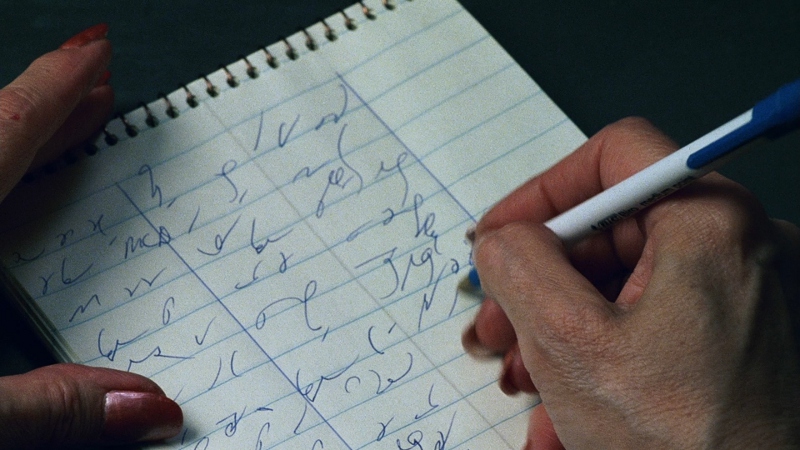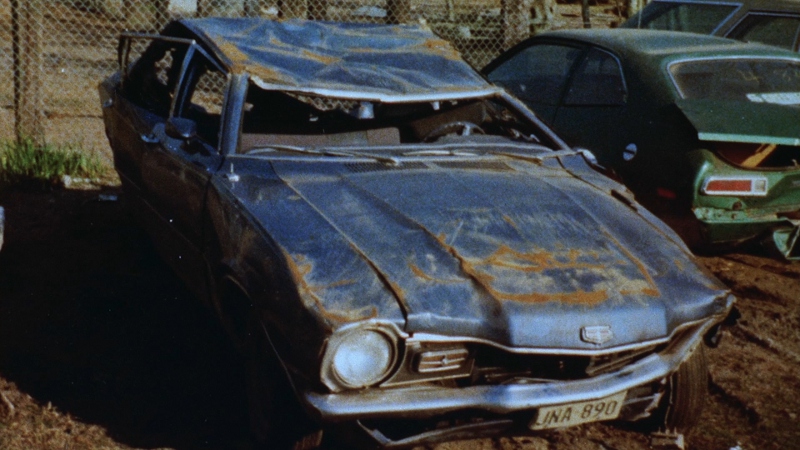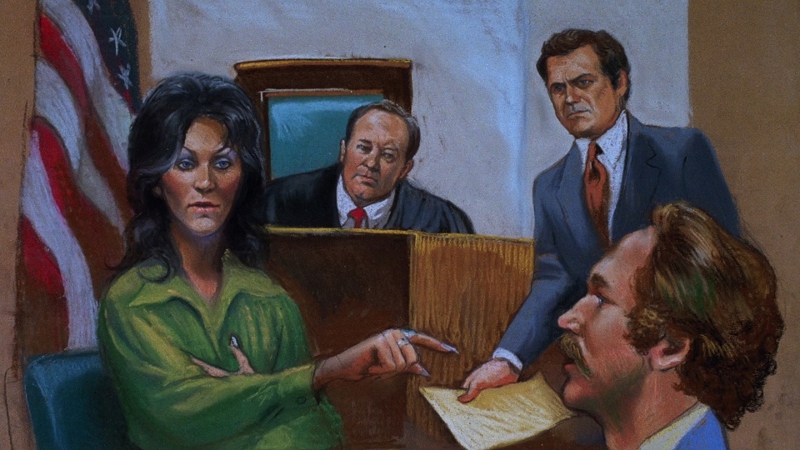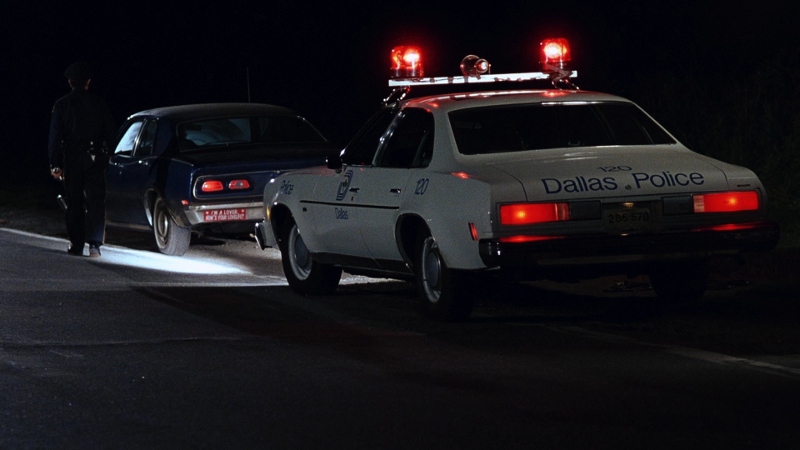| Reviews & Columns |
|
Reviews DVD TV on DVD Blu-ray 4K UHD International DVDs In Theaters Reviews by Studio Video Games Features Collector Series DVDs Easter Egg Database Interviews DVD Talk Radio Feature Articles Columns Anime Talk DVD Savant Horror DVDs The M.O.D. Squad Art House HD Talk Silent DVD
|
DVD Talk Forum |
|
|
| Resources |
|
DVD Price Search Customer Service #'s RCE Info Links |
|
Columns
|
|
|
Thin Blue Line: Criterion Collection, The
 Few documentaries have examined a historic event and actually changed history in the process. Errol Morris' career-defining The Thin Blue Line (1988) is one of those documentaries: it was birthed as a result of the director's temporary foray into private investigation, during which time he planned to interview prosecution psychiatrist "Dr. Death" James Grigson, whose testimonies led to the death sentences of more than 100 prisoners in Texas. While examining case files, Morris became fascinated by the 1976 murder of Dallas police officer Robert Wood: allegedly gunned down by Randall Adams (who had moved to town less than a month ago), the case went to trial and Adams was sentenced to death based on the testimony of detectives and eyewitnesses (including David Harris who, hours before the murder, gave Adams a ride after his car ran out of fuel). Adams languished in prison for more than a decade before Morris' three-year investigation became The Thin Blue Line, and the resulting film set him free. For several reasons, The Thin Blue Line would define the director's trademark visual and aural style for years to come. Though he employed a distinct front-facing angle for interview clips in his earliest films like Gates of Heaven and Vernon, Florida (released by Criterion in tandem with The Thin Blue Line next week), his extremely careful use of color gives these interviews anything but a loose, off-the-cuff appearance. These don't look natural in the least: from the contrast of Randall Adams' white shirt against a steely, dark gray background to the orange tones of David Ray Harris' jumpsuit, these techniques would later be put to good use in films like A Brief History of Time (1991). The Thin Blue Line also marked Morris' first collaboration with composer Philip Glass (The Qatsi Trilogy), and they'd pair up for two additional productions during the next 15 years (A Brief History, as well as 2003's The Fog of War). The Thin Blue Line makes use of supremely effective re-enactment footage to offer a multitude of perspectives during Wood's fatal shooting. These clips, though rarely lasting more than a minute apiece, serve as extensions that skillfully illustrate the on-screen testimonies in a tangible way: from subtle point-of-view shifts to the addition of new or different elements as told by each contributor, this format actively forces viewers to re-examine their own thoughts and beliefs as to what really happened that night. From a purely visual standpoint, they help to break up large chunks of talking-head interviews and evidence galleries...but from a narrative standpoint, they do so much more. Their presence is absolutely vital to the film's potency, but at a price: these re-enactments cost The Thin Blue Line an Academy Award nomination for Best Documentary that year, as it was subsequently categorized as "non-fiction". Taken as a whole, The Thin Blue Line is just as strong now as it was more than 25 years ago; it's the rare documentary that changed the genre as a whole, made a real-world difference at the same time, and has aged better than most. Its careful use of colors, textures, and editing techniques are matched only by the clear and concise way in which the narrative unfolds, offering more than enough proof that Morris' three-year investigation was time well spent. It probably represents the pinnacle of Morris' career thus far...and incidentally, it's his personal favorite as well. Criterion's long-awaited Blu-ray serves up a terrific A/V presentation and a few worthwhile extras, easily trumping MGM's DVD from nearly a decade ago. New and seasoned viewers alike should absolutely not pass this one up.

Criterion's liner notes for The Thin Blue Line claim that this 1080p transfer represents the film's "original 1.78:1 aspect ratio"...and it's also been supervised by director Errol Morris and producer Mark Lipson, so who am I to argue? Despite any nitpicks about the framing, this is an absolutely flawless presentation of the film that makes it all the more engaging for first-time viewers or those who haven't seen it in a decade or more. Grain is incredibly thick and rich in all the right ways, the film's specific color palette is replicated nicely, image detail is very strong, photos and evidence look better than ever, black levels and contrast are consistent from start to finish...I could go on and on, really, but I really don't have to. Let's just leave it at this: The Thin Blue Line's new high-definition digital restoration is one of the strongest in recent memory, and it couldn't have been paired with a more deserving film.
Presented in DTS-HD Master Audio 2.0 Surround (as opposed to PCM, Criterion's usual format of choice), The Thin Blue Line sounds as good as expected for an almost 30 year-old documentary. Philip Glass' original score benefits the most from this lossless bump: it occasionally drifts into the rear channels and sounds incredibly dynamic and nuanced. Dialogue, not surprisingly, is anchored square in the middle and occasionally gets a little buried in the action at normal listening levels...perhaps as a whole, it's just mixed a tiny bit quieter than your typical Blu-ray. Either way, what's here sounds excellent overall and, like the visuals, this represents a marked improvement over the MGM DVD. Optional English subtitles are included during the main feature, but none of the supplements.

Also included is a 1989 NBC Today Segment (5:46) featuring host Bryant Gumbel, Randall Adams (recently freed from prison), Adams' lawyer Randy Schaffer, and Errol Morris, who is connected via live satellite feed and briefly interacts with all participants before being cut for time. This is obviously more of a surface-level interview but fascinating from a historical perspective, and I'm glad it was dug out of the archives and preserved in such an appropriate place. It's a shame we couldn't get a complete update or more recent interview with Adams...but since the previously mentioned MGM DVD of The Thin Blue Line contained no bonus features of any kind, this is certainly a step in the right direction. These extras are presented in 1080i or 1080p and look as good as their source material allows.
Any way you slice it, Errol Morris' The Thin Blue Line is a landmark documentary that not only changed the genre as a whole...but more importantly, saved a man's life in the process. Morris' three-year investigation into Randall Adams' wrongful murder conviction yields wildly entertaining and densely layered results, both from a distinct visual perspective and an ever-twisting narrative. The film's terrific re-enactments are just icing on the cake, exposing us to a mysterious event from countless perspectives and changing our understanding of that fateful night each and every time. Criterion's Blu-ray offers just about a perfect level of support, serving up a top-tier A/V presentation and a slightly limited but completely appropriate collection of extras. Based on the film's substantial impact and this disc's terrific treatment of it, I've no choice but to award it with our most valuable rating: DVD Talk Collector's Series.
 |
|
| Popular Reviews |
| Sponsored Links |
|
|
| Sponsored Links |
|
|
| Release List | Reviews | Shop | Newsletter | Forum | DVD Giveaways | Blu-Ray | Advertise |
|
Copyright 2024 DVDTalk.com All Rights Reserved. Legal Info, Privacy Policy, Terms of Use,
Manage Preferences,
Your Privacy Choices | |||||||














